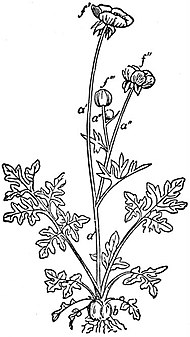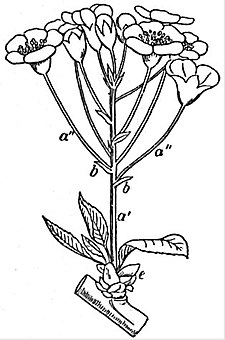producing flower-buds as it grows, the lower expanding first (fig. 8), or it is shortened and depressed, and the outer flowers expand first (fig. 9). The expansion of the flowers is thus centripetal, that is, from base to apex, or from circumference to centre.

|
|
Fig. 10.—Plant of Ranunculus bulbosus, showing determinate inflorescence. |
The second kind of inflorescence is determinate, definite or terminal. In this the axis is either elongated and ends in a solitary flower, which thus terminates the axis, and if other flowers are produced, they belong to secondary axes farther from the centre; or the axis is shortened and flattened, producing a number of separate floral axes, the central one expanding first, while the others are developed in succession farther from the centre. The expansion of the flowers is in this case centrifugal, that is, from apex to base, or from centre to circumference. It is illustrated in fig. 10, Ranunculus bulbosus; a′ is the primary axis swollen at the base in a bulb-like manner b, and with roots proceeding from it. From the leaves which are radical proceeds the axis ending in a solitary terminal flower f′. About the middle of this axis there is a leaf or bract, from which a secondary floral axis a″ is produced, ending in a single flower f″, less advanced than the flower f′. This secondary axis bears a leaf also, from which a tertiary floral axis a″′ is produced, bearing an unexpanded solitary flower f″′. From this tertiary axis a fourth is in progress of formation. Here f′ is the termination of the primary axis, and this flower expands first, while the other flowers are developed centrifugally on separate axes.
A third series of inflorescences, termed mixed, may be recognized. In them the primary axis has an arrangement belonging to the opposite type from that of the branches, or vice versa. According to the mode and degree of development of the lateral shoots and also of the bracts, various forms of both inflorescences result.
Amongst indefinite forms the simplest occurs when a lateral shoot produced in the axil of a large single foliage leaf of the plant ends in a single flower, the axis of the plant elongating beyond, as in Veronica hederifolia, Vinca minor and Lysimachia nemorum. The flower in this case is solitary, and the ordinary leaves become bracts by producing flower-buds in place of leaf-buds; their number, like that of the leaves of this main axis, is indefinite, varying with the vigour of the plant. Usually, however, the floral axis, arising from a more or less altered leaf or bract, instead of ending in a solitary flower, is prolonged, and bears numerous bracteoles, from which smaller peduncles are produced, and those again in their turn may be branched in a similar way. Thus the flowers are arranged in groups, and frequently very complicated forms of inflorescence result. When the primary peduncle or floral axis, as in fig. 8, is elongated, and gives off pedicels, ending in single flowers, a raceme is produced, as in currant, hyacinth and barberry. If the secondary floral axes give rise to tertiary ones, the raceme is branching, and forms a panicle, as in Yucca gloriosa. If in a raceme the lower flower-stalks are developed more strongly than the upper, and thus all the flowers are nearly on a level, a corymb is formed, which may be simple, as in fig. 11, where the primary axis a′ gives off secondary axes a″, a″, which end in single flowers; or branching, where the secondary axes again subdivide. If the pedicels are very short or wanting, so that the flowers are sessile, a spike is produced, as in Plantago and vervain (Verbena officinalis) (fig. 12). If the spike bears unisexual flowers, as in willow or hazel (fig. 13), it is an amentum or catkin, hence such trees are called amentiferous; at other times it becomes succulent, bearing numerous flowers, surrounded by a sheathing bract or spathe, and then it constitutes a spadix, which may be simple, as in Arum maculatum (fig. 14), or branching as in palms. A spike bearing female flowers only, and covered with scales, is a strobilus, as in the hop. In grasses there are usually numerous sessile flowers arranged in small spikes, called locustae or spikelets, which are either set closely along a central axis, or produced on secondary axes formed by the branching of the central one; to the latter form the term panicle is applied.
If the primary axis, in place of being elongated, is contracted, it gives rise to other forms of indefinite inflorescence. When the axis is so shortened that the secondary axes arise from a common point, and spread out as radii of nearly equal length, each ending in a single flower or dividing again in a similar radiating manner, an umbel is produced, as in fig. 15. From the primary floral axis a the secondary axes come off in a radiating or umbrella-like manner, and end in small umbels b, which are called partial umbels or umbellules. This inflorescence is seen in hemlock and other allied plants, which are hence called umbelliferous. If there are numerous flowers on a flattened, convex or slightly concave receptacle, having either very short pedicels or none, a






